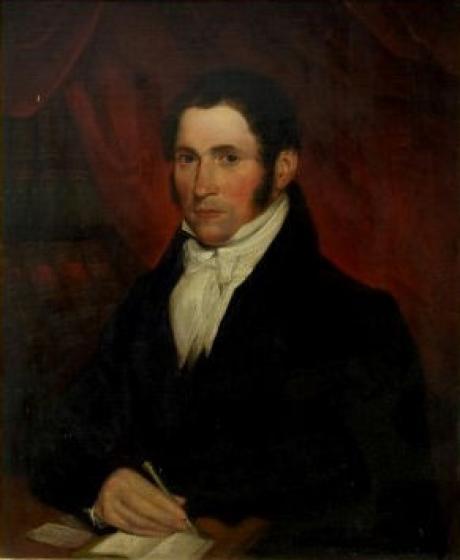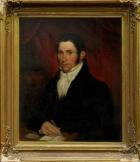signed on the letter " G Hughes/ .......Painter/.........London"
By Descent from the Torrance family.
It is likely that this portrait and the companion portrait was painted on one of the many occaissions when John and Elisabeth visited their small estate in John's native Scotland known as the 'Gatehouse'. They also educated all their sons in England and consequently they made frequent visits there. This portrait and its companion has been in the Scottish branch of the Torrance family until now.
JOHN TORRANCE, merchant, shipper, and entrepreneur; b. 8 June 1786, probably at Larkhall in Lanark County, Scotland, son of Thomas Torrance; d. 20 Jan. 1870 at Montreal.
The five brothers of the Torrance family came from the Galloway area of Scotland to the Canadas via New York shortly after 1800. Thomas* established himself as a general merchant in Montreal. John, aged 21 when he came to Montreal, was residing in Quebec City, probably as Thomas’ representative, when he married Elizabeth Fisher (1794–1862), daughter of Duncan Fisher*, a Montreal merchant, at Montreal on 28 May 1811. Their marriage contract allowed her £1,000 should she outlive him, an indication that he was already prospering. They were to have 15 children, all of whom lived to adulthood; among their sons-in-law were Liverpool merchants and Alexander Tilloch Galt*.
John had returned to Montreal by 1814 and opened his own general store on Saint-Paul Street, near that of Thomas. By 1826 David Torrance*, a son of John’s brother James of Kingston, had become a clerk in John’s business, and in 1832 he married John’s eldest daughter; they were business partners from 1833 until John retired in 1853. Their association may explain why one of John’s sons, James, opened a rival firm.
John Torrance and Company dealt in a wide variety of goods, but specialized in groceries, spirits, and particularly tea. In the late 1820s, by importing tea directly from China and India, it was the first to rival the East India Company monopoly controlled by Forsyth, Richardson, and Company. From their own bonded warehouse the Torrances supplied and made loans to Upper Canadian merchants such as Jacob Keefer*. Communications being of the greatest importance to their business, they developed the Montreal and Quebec Steamboat Company, which first competed with and afterwards became allied with the Molson interests. With the exception of the Molsons, the Torrances probably did more than any other group to establish the St Lawrence steamboat services [see David Torrance*].
The Torrances were equally interested in railway development. As early as 1832 they were among the incorporators of the Champlain and St Lawrence Railroad. By 1847 their firm had invested £1,000 in the St Lawrence and Atlantic Railroad, a scheme promoted by John Alfred Poor* to link Montreal with the year-round port of Portland, Maine. John was a director from 1847 until the line became the Portland division of the Grand Trunk Railway in 1853. The president was Galt, and the directors included William Molson*, who was closely associated in John’s other railway speculations. These involved a complex chain of railway incorporations to link Montreal with its western hinterland and New York State. In 1846 Torrance was an incorporator of the Montreal and Lachine Railroad Company, of which he was later a director; when it became part of the Montreal and New York Railroad Company in 1850, Torrance had £500 invested and was again a director. He was also a director of the St Lawrence and Ottawa Grand Junction Railroad Company, chartered in 1850, to extend the Montreal and Lachine to Prescott, Canada West. Torrance developed close connections with American entrepreneurs, including Poor and Commodore Cornelius Vanderbilt of New York; in 1846 John’s son Daniel married the commodore’s daughter and later became vice-president of Vanderbilt’s New York Central Railway.
John Torrance’s financial activities complemented his commercial interests. He was a stockholder in the short-lived Bank of Canada in Montreal, and was elected a director of the Bank of Montreal in 1826, after the death of his brother Thomas, one of the early directors. John retired in 1857.
Through the 1840s John was a director of the Montreal Provident and Savings Bank (established 1841) and at one time had £2,000 invested in the City Bank. Insurance connections were also necessary to his shiping interests. From its establishment in 1840, until at least 1854, he was a director of the Montreal Fire, Life, and Inland Navigation Assurance Company, of which James Ferrier* was president and William Dow another director. By the 1850s Torrance was the Montreal director for the Equitable Fire Insurance Company of London, England. He further invested in a variety of land speculations and mortgages.
Although interested in political movements only as they affected commerce, Torrance was active in the development of Montreal. A founder of the Committee of Trade in 1822 and a petitioner for municipal incorporation in 1828, he was one of the first elected city councillors in 1833. Like most Montreal businessmen he joined the city’s militia, being commissioned lieutenant in 1821, captain in 1830, and major in 1845. His most important foray into national politics came in 1849, when his was the first of the initial 325 signatures to the Annexation Manifesto, protesting against Britain’s free trade and policies on responsible government. Torrance was elected one of the vice-presidents of the Montreal Annexation Association. The movement soon died but because of it Torrance was dismissed from the militia in January 1850.
Originally a member of the St Gabriel Street Presbyterian Church, Torrance, like his nephew David, became a Methodist and a strong supporter of St James Street Methodist Church, and assisted Dorchester Street Church in 1864. A supporter of various literary and educational associations, he was a life governor of the Montreal General Hospital and a founder and trustee of the Mount Royal Cemetery. He made gifts to McGill University including a fund for a gold medal in law as a memorial to his wife. His son Judge Frederick William Torrance was closely connected with this institution. John Torrance’s hobby was gardening, and he was an incorporator of the Horticultural Society of Montreal in 1849. His 42-room mansion on then fashionable Saint-Antoine Street was renowned for its acres of gardens, greenhouses, vineries, and orchards. The estate was also famous for its high brick walls and great gate which according to family tradition closed firmly at 10 p.m.
When John Torrance died, he was not only a patriarch of Montreal, but also, as the Gazette commented, “one of our wealthiest citizens.” His fortune was divided among his many children and his business was ably carried on by David, whose career closely paralleled his own. Today Torrance and his family are virtually forgotten. They were not active in politics, except for Galt, nor did they leave their name to surviving corporations or endowed institutions, as did the Molsons and the Redpaths. Yet the role played by John, his brother Thomas, and his nephew David in the evolution of what Donald Grant Creighton has called the “commercial empire of the St. Lawrence” was important. John Torrance may have chosen the right location and come at the right time, but his industry, astuteness, and intelligence did much to build up his city as well as his own fortune.
John and Elizabeth's eldest child, Jane (1812–1875), married her first cousin and the business partner of her father, David Torrance, President of the Bank of Montreal. Their third child, Daniel (1815–1885), married Sophia Vanderbilt, daughter of the 'Commodore', Cornelius Vanderbilt, and they were the parents of Mrs Frederick William Vanderbilt. Their tenth child, Elliot (1828–1850), married Sir Alexander Tilloch Galt, and after her death Galt married Elliot's younger sister, Amy Florence Torrance (d.1936).[4]
Frederick H. Armstrong Dictionary of Canadian Biography.
George Hughes exhibited 67 paintings at the Royal Academy, he worked and lived in London. among his sitters was the acrtress Miss Ellen Tree. he praciticed as a portrait painter and miniaturist.



